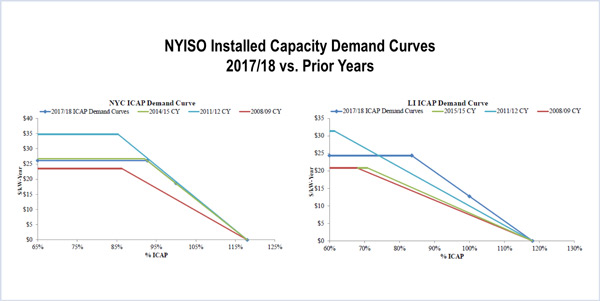By Rich Heidorn Jr.
FERC on Wednesday again rejected a request that it include the cost of emissions controls in the peaking plant design for the New York Control Area (NYCA) capacity demand curve (ER17-386).
The commission rejected a rehearing request by the Independent Power Producers of New York (IPPNY), which contended that the state’s Siting Board is likely to require selective catalytic reduction (SCR) emissions controls in the future because of concerns over fossil fuel generation.
FERC repeated its conclusion that SCR controls are not required for peaking plants in NYCA load zones C and F and that peakers can meet environmental rules by limiting their operating hours, dismissing as “speculative” IPPNY’s prediction of tighter controls in the future.
IPPNY had asked the commission to reconsider its January ruling approving NYISO’s revised demand curve for delivery years 2017/18 through 2020/21. (See FERC OKs NYISO Demand Curve Reset.)
The January order continued the use of F class frame peaking turbines as the proxy unit for setting the cost of new entry. It also continued the requirement that peaking plants include dual-fuel capability and SCR emissions controls for the New York City, Long Island and G-J Locality demand curves.
But the commission rejected the ISO’s proposal to extend the SCR requirement to the NYCA, where gas-only designs were permitted. Under current rules, FERC said, the NYCA peaking plant can operate under an annual operating hours limit in lieu of installing SCR emissions controls.
In its order this week, FERC also rejected IPPNY’s request to shorten the amortization period or increase the rates of return for peakers in zones C and F. IPPNY said the changes would capture the risk that emissions rules on those plants will be tightened in the future.
The commission deemed as “speculative” the risk of having to retrofit an NYCA peaking plant with SCR controls, and also found NYISO’s proposed amortization period and return on equity to be just and reasonable.
“The commission need not consider alternatives,” FERC said. “Nevertheless, IPPNY provides no alternatives, but only a scant statement that the commission should impose either ‘a significantly shorter amortization period than the NYISO’s proposed 20-year period or an increased required return.’ In contrast, NYISO’s amortization period and return on equity were the subject of analysis by [the ISO’s independent consultant] and extensive stakeholder discussions.”


